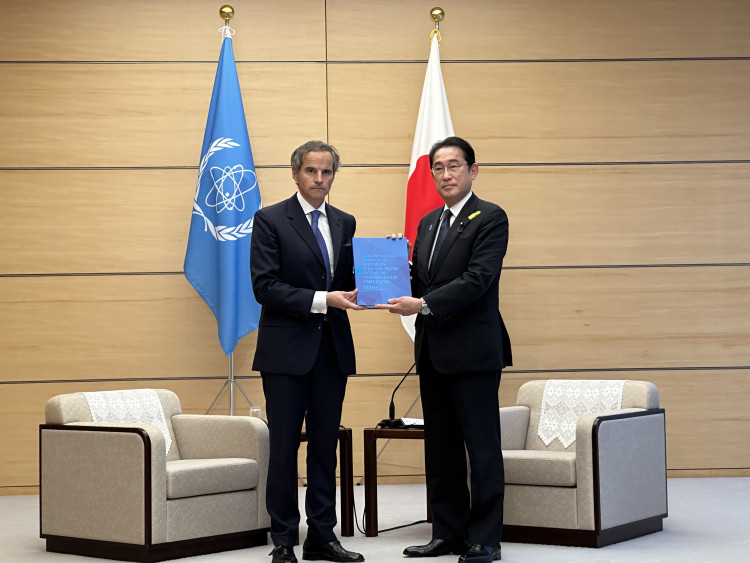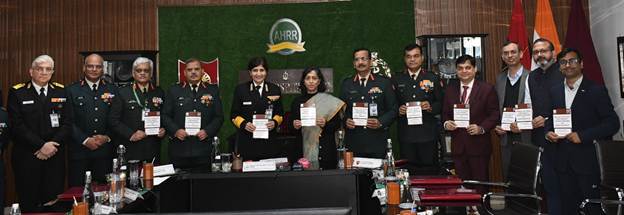
IAEA D-G Rafael Mariano Grossi presenting the report to Japanese PM Fumio Kishido in Tokyo today.
Tokyo/Beijing: An International Atomic Energy Agency (IAEA) safety review concluded that Japan’s plans to release treated water stored at the Fukushima Daiichi nuclear power station into the sea are consistent with IAEA Safety Standards.
China, which in the past was critical of Japan’s plans, said before the release of the report that the mandate of the agency is limited to evaluating the ocean discharge plan only by the Japanese side from the very start and the agency does not have the mandate to evaluate other options. Beijing also claimed that the report would not prove the discharge was legitimate and justified and “exempt the Japanese side from its due responsibilities and obligations under international law”.
The report, which was formally presented by IAEA Director-General Rafael Mariano Grossi to Japanese Prime Minister Fumio Kishida in Tokyo today, stated that the discharges of the treated water would have a negligible radiological impact on people and the environment.
It may be mentioned that the Great East Japan Earthquake with a magnitude of 9.0 on March 11, 2011 subsequently caused a tsunami that substantially destroyed the Fukushima Daiichi Nuclear Power Station (FDNPS), operated by the Tokyo Electric Power Company (TEPCO).
The accident at Fukushima Daichi Nuclear Power Station and the subsequent operations at the plant resulted in the accumulation of large amounts of water stored on the site. Since the reactor vessels were no longer intact, and the nuclear material from the cores was no longer contained in the reactor vessels, the groundwater coming into the reactor buildings could mix with radioactive debris resulting in contaminated water.
The highly radioactive contaminated water was collected by TEPCO and stored on-site in special tanks to prevent it from reaching the environment in its current state. TEPCO then developed the Advanced Liquid Processing System (ALPS), which it used to remove most of the radioactive contamination from the water and thus reduce the dose to workers from this stored water.
In April 2021, the Government of Japan published its policy on how it would manage this water. It decided to discharge it gradually into the sea after specific treatment. Shortly after the decision was made, the Government of Japan requested that the IAEA undertake an independent safety review of Japan’s implementation of its policy against the international safety standards.
The report is the outcome of nearly two years of work by an IAEA Task Force made up of top specialists from within the Agency advised by internationally recognised nuclear safety experts from eleven countries. They reviewed Japan’s plans against IAEA Safety Standards which serve as a global reference for protecting people and the environment and contribute to a harmonized high level of safety worldwide.
“Based on its comprehensive assessment, the IAEA has concluded that the approach and activities to the discharge of ALPS treated water taken by Japan are consistent with relevant international safety standards,” IAEA Director General Rafael Mariano Grossi said in a foreword of the report.
“Furthermore, the IAEA notes the controlled, gradual discharges of the treated water to the sea, as currently planned and assessed by TEPCO, would have a negligible radiological impact on people and the environment,” he added.

After taking the decision in April 2021 to discharge the water stored at the Fukushima Daiichi nuclear power station (FDNPS) into the sea, Japan requested the IAEA to conduct a detailed review of the safety-related aspects of the plan.
IAEA Director General Grossi accepted Japan’s request and committed to be involved before, during, and after the water discharges.
The water stored at the FDNPS has been treated through an Advanced Liquid Processing System (ALPS) to remove almost all radioactivity, aside from tritium. Before discharging, Japan will dilute the water to bring the tritium to below regulatory standards.
Like elsewhere in the world, decisions related to nuclear safety are a national responsibility and Japan’s Nuclear Regulation Authority (NRA) approved the plan in May.
The IAEA’s review addressed all key safety elements of the water discharge plan in three major components: assessment of protection and safety; regulatory activities and processes; and independent sampling, data corroboration, and analysis.
Over the past two years, the Task Force has conducted five review missions to Japan, published six technical reports, met many times with the Japanese Government and Japan’s Tokyo Electric Power Company (TEPCO), the FDNPS operator, and analysed hundreds of pages of technical and regulatory documentation. Task Force members have also several times visited the site in eastern Japan to review discharge preparations there.
Director General Grossi said the report issued today “represents a significant milestone in the IAEA’s review” but that “our task is only just beginning”.
“The IAEA will continue to provide transparency to the international community making it possible for all stakeholders to rely on verified fact and science to inform their understanding of this matter throughout the process,” he said.
The IAEA‘s safety review will continue during the discharge phase. The Agency will also have a continuous on-site presence and provide live online monitoring on its website from the discharge facility.
“This will ensure the relevant international safety standards continue to be applied throughout the decades-long process laid out by the Government of Japan and TEPCO,” Director General Grossi said.
Earlier, China had alluded to a Global Times survey conducted in 11 countries including China, South Korea, Japan, the Philippines and New Zealand which indicated that of the 11,000 respondents, nearly 90 per cent showed worries, fear and anger toward the Japanese government, and more than 90 per cent of them supported their countries in taking measures to intervene in Japan’s ocean discharge plan.
– global bihari bureau





